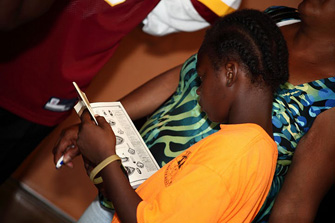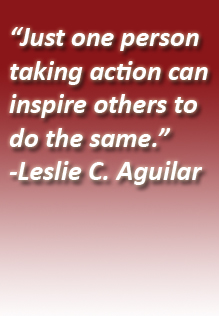Help the Foundation Put "A Book in Every Kid's Hands"
January 14, 2011

Find out how you can help put "A Book in Every Kid's Hands"!
The Chris Draft Family Foundation set out to empower families and change lives for the better since its inception in 2006. The Foundation has led the “Get Checked, Get Fit™” and “Literacy Leaders” health and wellness initiatives. “Get Checked Get Fit™” encourages youth and families to make positive choices regarding overall health and wellness. “Literacy Leaders” focuses on early childhood reading, adolescent literacy, and family literacy through, “changing lives, saving lives, one book at a time.”
The Foundation partnered with Alcon Entertainment (producers of THE BLIND SIDE), Reading is Fundamental (RIF) and the Department of Education to start Project Blind Side, which spread awareness about the importance of literacy and created excitement for the 2010-2011 school year.
Through local screenings of THE BLIND SIDE, the foundation carries the film’s message of hope into communities nationwide and inspires the youth of today to believe that they have the power to make a difference.
Project Blind Side has since evolved into “A Book in Every Kid’s Hands.” This initiative’s goals are aligned with Project Blind Side, but allows the initiative to transcend beyond the movie nationwide. The Foundation has used these platforms to tackle literacy and encourage education on a national level.
Why "A Book in Every Kid's Hands"?
Research taken from the Department of Education shows “… that academic achievement stalls and, for far too many disadvantaged children, actually worsens if they are not engaged in educational activities during the summer. In fact, most low-income children can lose more than two months of progress in reading achievement during the summer break.”
Our goal is to combat illiteracy and help create a national movement led by the Chris Draft Family Foundation and select NFL players in order to reform the educational system.
Literacy Facts & Stats According to Reading Is Fundamental:
A great number of children and adults struggle with reading.
•Thirty-three percent of 4th grade public school students are at or below the “Basic” level on the 2009 National Assessment of Educational Progress (NAEP) reading tests. Twenty-six percent of 8th grade public school students performed at or below the “Basic” level on the NAEP reading test (NCES, 2009).
•Among 4th graders, 53 percent of African American students, 52 percent of Hispanic students, and 48 percent of American Indian students scored below the “Basic” level on the NAEP reading test. Among 8th graders, 44 percent of African American students, 41 percent of Hispanic students, and 37 percent of American Indian students scored below the “Basic” level on the NAEP reading test (NCES, 2009).
•Forty-nine percent of 4th graders eligible for free and reduced-price meals finished below “Basic” on the NAEP reading test. Forty percent of 8th graders eligible for free and reduced-price meals scored below “Basic” on the NAEP reading test (NCES, 2009).
•The number of high school seniors who read at or above “Proficient” has been declining since 1992, according to the NAEP reading test (NCES, 2002).
Children of all ages need year-round access to books and increased reading motivation.
•Fifty-three percent of 4th graders report that they read for fun on their own “Almost Every Day.” Among 8th graders, only 20 percent report reading for fun on their own “Almost Every Day” (NCES, 2009).
•Fourth graders who reported reading for fun “Almost Every Day” scored 3 percent higher (215) on the NAEP reading test than peers who reported reading “Never or Hardly Ever” (195) (NCES, 2009).
•Fourth graders who reported having 25 books or more at home had higher scores on reading tests than children who reported they didn’t have that many books (NCES, 2003).
•During the summer break, low-income students lose more than two months of reading achievement (Cooper, 1996).
•About two-thirds of the 9th grade achievement gap between lower- and higher-income youth can be explained by unequal access to summer learning opportunities during the elementary school years. As a result, low-income youth are less likely to graduate from high school or enter college (Alexander et al., 2007).
•Parents consistently cite summer as the most difficult time to ensure that their children have productive things to do (Duffett et al., 2004).
Families play an important role in their children’s reading success.
•Forty-three percent of adults read at or below the “Basic” level. This accounts for roughly 93 million individuals (NAAL, 2003).
•Twenty-six percent of children who were read to three or four times in the last week by a family member recognized all letters of the alphabet. This is compared to 14 percent of children who were read to less frequently (NEA, 2009).
•Where parent involvement is low, the classroom mean average is 46 points below the national average. Where involvement is high, classrooms score 28 points above the national average—a gap of 74 points (NEA, 2009).
•Less than half of families read to their kindergarten-age children on a daily basis (West et al., 2000).

